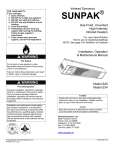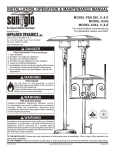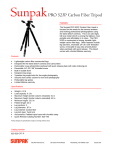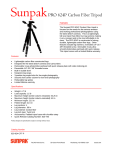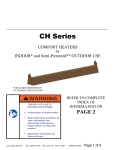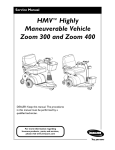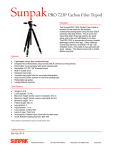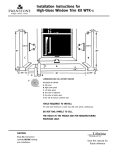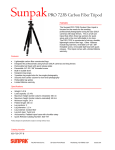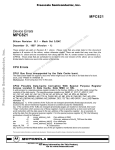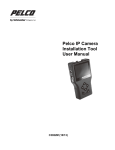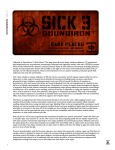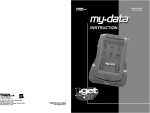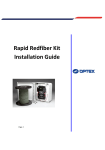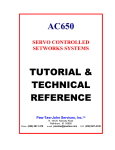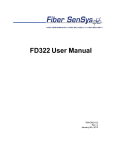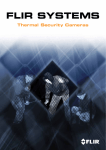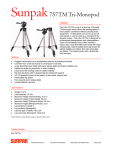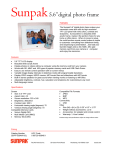Download Sunpak Owners Installation Manual
Transcript
Infrared Dynamics FOR YOUR SAFETY: If you smell gas: 1. Open windows. 2. DO NOT try to light any appliance 3. DO NOT use electrical switches 4. DO NOT use any telephone in your building 5. Leave the building 6. Immediately call your local gas supplier after leaving the building. Follow the gas supplier’s instructions. 7. If you cannot reach your gas supplier, call the Fire Department SUNPAK ® Gas-Fired, Unvented High-Intensity Infrared Heaters For use Indoor/Outdoor Commercial Outdoor Residential ONLY Installation, Operation & Maintenance Manual WARNING Fire Hazard Do not store or use gasoline or other flammable vapors and liquids in the vicinity of this or any appliance. Failure to follow these instructions can result in death, injury or property damage. Model S25 Model S34 WARNING Fire and Explosion Improper installation, adjustment, alteration, service or maintenance can result in death, injury or property damage. Read the installation, operation and service manual thoroughly before installing or servicing this equipment. Installation and replacement of gas piping, gas utilization equipment, or accessories, and repair and servicing of equipment shall be performed by a qualified agency familiar will all precautions required regarding this type of equipment and that has complied with all requirements of the authority having jurisdiction. Installer Please take the time to read and understand these instructions prior to any installation. Installer must be given a copy of this manual to the owner. Owner Keep this manual in a safe place in order to provide your serviceman with the necessary information. Infrared Dynamics, Inc. 3830 Prospect Avenue Yorba Linda, CA 92886 Telephone: (714) 572-4050 Fax: (714) 572-6093 Toll Free: (888) 317-5255 www.sunpak.us © Copyright 2011 Infrared Dynamics, Inc Printed in the U.S.A. P/N 65132-7/11 Sunpak® Infrared Heaters Starting Your Heater Table of Contents 1. 2. 3. 4. 5. 6. Turn gas and 24 VAC electrical power “ON”. The pilot and burner should light within 4 seconds. A flame sensor will shut off the spark. If the burner does not light within 15 seconds the flame sensor will shut “OFF” the gas valve. To relight the pilot and burner, shut “OFF” power. Wait 5 minutes. Turn power back “ON”. Owner’s Manual Design Guide Installation / Service Instructions Replacement Parts Trouble Shooting Guide Warranty If the heater will not light, turn the manual gas valve to “OFF” position and the electrical switch “OFF” to the heater and call your quality service agency or gas supplier. Shutting Down Your Heater WARNING Turn electrical power to the heater “OFF” . Should you need to shut down your heater for service or maintenance, the manual gas valve next to the heater should also be turned “OFF”. Prop. 65 - Carbon Monoxide If not installed, operated and maintained in accordance with manufacturer’s instructions, this product could expose you to substances in the fuel or from combustion, including Carbon Monoxide, which can cause death or serious illness and which are known to the State of California to cause cancer, birth defects or reproductive harm. Performing Routine Maintenance Overtime, particularly during long periods of disuse, the heater can accumulate dirt and debris in and around the pilot and the burner. Routine maintenance should be performed at least once a year by a qualified service agency to insure the heater is operating properly. More frequent service may be required for heaters located near waterfronts. Stainless Steel Heater Owner’s Manual Stainless steel does not “rust”; however air pollution can leave brown deposits on heaters. We recommend washing the outer stainless steel casing only with a mild detergent solution and wiping it dry with a soft cloth to bring back the original shine. The stainless steel may be expected to permanently darken around the top of the heater over time with extended use. Before Starting Your Heater Before you start your heater examine the heater installation to determine that: • Areas immediately around the heater including the air inlet and flue areas are free from obstructions. • Physical support of the heater is sound. • There is no obvious deterioration of the heater. Before You Remodel Should you plan to make any changes to the patio or building structure after heaters have been installed, your heater installation must be reviewed by a qualified agency to insure that clearances from combustion material and ventilation requirements are maintained after alterations are complete. When plastic curtains or drops are used to enclose a patio you must take steps to insure that Sunpak heaters have the required permanent access to outside air. If a patio is to be partially enclosed a qualified agency familiar with this type of heating equipment must be consulted to insure the safe operation of this equipment. Starting and Shutting Down Your Heater Sunpak utilizes an automatic ignition system. Follow these important safeguards. • Never attempt to manually light the burner with a match or other source of flame. • Read and follow the operating instructions on the inside of heater door especially the item that reads as follows: Wait 5 minutes to clear out any gas. Then smell for gas. If you smell gas follow the instructions on the front of this manual regarding gas leaks. If you don’t smell gas, go to the next step. • If a suspected malfunction occurs with your gas control system, such as the burner does not light when it should, refer to the section ‘Shutting Down Your Heater’. 2 Sunpak® Infrared Heaters Heater Layout and Design Sunpak® heaters were specifically designed to provide heated comfort in an outdoor environment. They have been used on outdoor patios across the United States and Canada for over 20 years. When properly integrated into a patio design, Sunpak® heaters generally increase the comfort level 5 to 10 degrees Fahrenheit outdoors. The heating effectiveness will depend on air temperature, wind velocity and other factors. Whenever possible local Sunpak® installations should be reviewed to determine the effectiveness for regional environments. The environments in which Sunpak® heaters are utilized vary greatly. As an outdoor rated heater it has passed basic wind and rain tests. This does not mean the heater cannot be damaged by the environment or when operated in very windy conditions. For this reason it is strongly suggested that heaters be inspected and if necessary repaired annually or before each heating season. The variable environments in which Sunpak® heaters are applied means that these general guidelines are general by necessity and may need to be refined for local conditions. These guidelines are to be used in combination with the installation instructions. Breezy conditions must be considered when heating any patio. Windbreaks can be extremely effective in increasing comfort and reducing heating costs. Windbreaks must be designed in such a way to allow for the necessary fresh air and ventilation for proper heater operation (see ventilation of installation section). WARNING Asphyxia / Carbon Monoxide Heater requires adequate combustion air and ventilation in order to operate safely. Improper ventilation can generate carbon monoxide or other harmful gases that could result in death or breathing difficulties. Small or enclosed patios may not be appropriate to for this type of heater. Sunpak heaters must always be operated in a location that allows uniform air pressure around the heater. If only part of the heater is located in a wind protected zone damage to the heater may occur. Time should be taken to observe how the wind will affect the heaters under local conditions. Caution Patio Design Consideration Heater placement is critical for effective and efficient patio heating. If heaters are placed too close together or mounted too low, people become uncomfortable. If heaters are placed too far apart on a breezy, wind-swept patio the patio may never get warm. Sunpak® heaters work best if they are placed in areas of the greatest heat loss, such as the open side of a semiprotected patio area. The Sunpak® heater may be mounted at up to a 30 degree angle or face down. Note that the top clearances required from combustible material increases when heaters are at any angle. The heater must always be horizontal to the floor. WARNING Fire and Explosion Proper clearance for combustible materials must be maintained. See installation section of this manual for required clearances for different model and mounting options. Sunpak heaters may be laid out in a number of configurations depending on the structural constraints of the patio and heating requirements. One approach is to face heaters straight down over the table and seating areas. Another approach is to locate heaters to the side and to angle them inward. A third approach is to cluster the heaters in the center of the patio and angle heaters outward. It all depends on the needs of a particular patio. Damage to Heater Failure to operate heater in a uniform air pressurize environment or under erratic wind conditions can cause over-heating of controls, and damage to the front grill and burner. Temperature Control A thermostat can be incorporated into the electrical circuit; however this may not be the best means of temperature control. Because the infrared heat warms people and objects, when used outdoors the heater may not increase the air temperature and thus the thermostat is never satisfied. When multiple heaters are used it is suggested that they be put on individual switches to provide flexibility in heating. Typically all the heaters would be turned on to heat a cold patio, and then heaters would be turned off selectively as people settle in. A timer or master switch may be convenient to ensure the heaters are not turned on when the patio is not in use. 3 Sunpak® Infrared Heaters CEILING MINIMUM CLEARANCE FROM COMBUSTIBLE MUST BE MAINTAINED (see chart opposite page) SUNPAK will raise the comfort level 5-10º Fahrenheit outdoors. The above coverage table was based on still breeze conditions. Under windy conditions more heat will be required. It is recommended that a windswept patio be designed with wind breaks to stabilize the patio environment. Wind breaks shall NOT interfere with the ventilation of combustion air requirement of the heater(s). 4 ANGLE MOUNTING: Most models of the SUNPAK heater may be angle-mounted to a maximum of 30º to accommodate mounting the heaters around the edges of the patio. Note that the top clearance to combustibles increase when heater is tipped from the horizontal. NOTE: Local codes may have special requirement regarding head clearance requirements. Some local codes require all portions of overhead radiant heaters to be located at least 8 foot above the floor. Sunpak® Infrared Heaters 5 Sunpak® Infrared Heaters Gas Supply Installation/Service Instruction The gas inlet supply pressure and manifold pressure required for each heater are listed below. For gas supply line pressures in excess of ½ psig, consult with your representative or the factory. Receiving Equipment On receipt of equipment it is suggested that a visual inspection be made for external damage to the carton. If the carton is damaged, a note should be made on the Bill of Lading when signing for the equipment. Remove the heater from the carton. If there is damage, report the damage to the carrier immediately. Gas Inlet Pressure Maximum Pressure Minimum Pressure Manifold Pressure Nat Gas ½ psig 6” W.C. 5” W.C. Propane ½ psig 11” W.C. 10” W.C. INSTALLATION INSTRUCTIONS It is important that the gas piping system be adequately sized for all the gas appliances it serves. Important Notice Clearances These instructions are intended for qualified personnel, specifically trained and experienced in the installation of this type of equipment and related system components. Some states or provinces require installation and service personnel to be licensed. If your state or province is such, be sure your contractor bears the appropriate license. Persons not qualified shall not attempt to fix this equipment nor attempt repairs according to these instructions. Each heater must be installed such that the following “Minimum Clearance to Combustible Materials’ are maintained. Combustible materials include wood, compressed paper, plant fibers, and plastic, Plexiglas or other materials capable of being ignited and burned. Such materials shall be considered combustible even though flame-proofed, fire retardant treated or plastered. Additional clearance may be required for glass, painted surfaces, vinyl siding or other materials which may be damaged by radiant or convection heat. Adequate space around each heater is required even when the materials surrounding the heater are noncombustible to provide adequate combustion air and ventilation of exhaust gases. Heaters should never be located in a ceiling recess or soffit. The stated clearance to combustible materials represents a surface temperature of 90ºF (32ºC) above room temperature. Building materials with a low heat tolerance (such as plastic, vinyl siding, canvas, tri-ply, etc.) may be subject to degradation at lower temperatures. It is the installer’s responsibility to assure that adjacent materials are not subject to degradation. In locations used for storage of combustible materials, signs shall be posted to specify the maximum permissible stacking height to maintain required clearances from the heater to combustible materials. WARNING Asphyxia, Explosion or Fire Improper installation, adjustment, alteration, service or maintenance may create a hazard resulting in asphyxiation, explosion or fire, or damage to the equipment. Code Requirements Installation must be in accordance with local codes, or in the absence of local codes, with the latest edition of the National Fuel Gas Code, ANSI Z224 and National Electrical Code ANSI/NFPA 70, and for Canada, the latest edition of CAN/CGA-B149.1 and B149.2 and Canadian Electrical Code, CSA C22.1 Part 1 and Part 2. • Heaters to be installed in Aircraft hangars must be installed in accordance with American National Standards for Aircraft Hangars, ANSI/NFPA No. 409. • Heaters to be installed in Public Garages must be installed in accordance with NFPA No. 88A, Standards for Parking Structures. • Heaters must be installed so that minimum clearances marked on the heaters will be maintained from vehicles parked below the heater. • Each heater must be electrically grounded in accordance with the National Electrical Code, ANSI/NFPA 70, when an external electrical source is utilized. In Canada, the CSA Canadian Electrical Code, C22.1 Part 1 applies. OPTIONAL MOUNTING KIT (#12006): Optional Mounting Kit is available from your heater supplier. Whether the mounting kit is used or not, minimum clearance from combustibles must be observed as follows: WARNING: The clearances shown below are also applicable to vehicles parked below heaters. Model S25 S34 *S25 S34 Input BTUH 25,000 34,000 25,000 34,000 Side In 24” 24” 24” 24” Rear In 12” 17” 8” 8” Ceiling In 9” 13” 14” 18” Below In 48” 48” 48” 48” Mtg. Angle HORIZ HORIZ 30º MAX 30º MAX Above clearance apply to models on either natural or LP gas. *Model S25 for LP gas for use in horizontal position only . 6 Sunpak® Infrared Heaters 7 Sunpak® Infrared Heaters Fire Sprinklers Fire Sprinklers must be located at an appropriate distance from each heater to avoid accidental activation of the sprinkler. Ethylene glycol or propylene glycol must never be used in fire sprinkler systems where heaters are present as these substances may become flammable when heated. A fire sprinkler professional must be consulted when heaters are installed where fire sprinklers are present to insure that heaters and the fire sprinkler system are properly integrated. Specific guidelines can be found in NFPA 13 regarding design and specifications for Fire Sprinkler Systems near heaters. CAUTION Sharp Edges Every effort has been made to remove sharp edges from this heater; however care should be taken to avoid injury when reaching inside the heater during installation and when servicing this unit. Electrical 1. Provide only 24 VAC with a NEC Class 2 transformer to the heaters. Each heater requires approximately 20VA or 0.8 amps. When multiple heaters are connected to one transformer, the transformer must be sized to accommodate the entire load. A transformer must NEVER be located inside the heater control compartment. 2. Control wire used to electrically connect one or more heaters together must have adequate capacity and insulation temperature rating for the total connected load. Use at least 18 GA wire up to 50 feet from heater to transformer or wall switch. Use a minimum of 16 GA wire for over 50 feet distance. 3. If any of the original wire supplied with the appliance must be replaced, it must be replaced with wiring material having a temperature rating of at least 105 degrees Centigrade. WARNING Suspension Hazard Mounting kits and hanging supports must be able to withstand a minimum working load of 75 lbs (33 kg). Failure of the supports can result in death. Local codes regarding head clearance requirement must be observed. Heater Mounting and Support Heaters shall be mounted in a fixed position independent of gas and electrical supply line. Hangers and brackets shall be of noncombustible material. Heaters subject to vibration shall be provided with vibration isolating hangers. Suitable materials for hanging infrared heaters are steel pipe, steel channel, or fabricated hangers of at least 16-gage material. Hanger and brackets must be secured with adequate anchor to a secure structure using good building practices. Additional bracing to protect against seismic forces may be required in seismically active areas. WARNING Electrical Shock Hazard Disconnect electrical power and gas supply before servicing This heater must be connected to a properly grounded electrical source. Failure to follow these instructions can result in death or electrical shock. 8 Sunpak® Infrared Heaters Ventilation 1. 2. 3. It is required that areas above the heater be properly vented to allow for necessary combustion air and removal of combustion gases. Heaters shall be provided with natural or mechanical means to supply and exhaust at least 4 cfm per 1,000 BTU per hour of heater input. Exhaust opening for removing the flue products shall be above the level of the heaters. Heater ventilation must comply with state and local codes. Gas Piping 1. 2. 3. 4. 5. 6. 7. A minimum pipe size of ½” is required for inlet piping. A ½” leaver handled shut-off gas cock should be installed within 6 feet of the appliance for servicing the unit. Check with local and state plumbing and heating codes regarding sizing of gas lines. All gas pipe connections to the heater(s) must be sealed with a gas pipe compound resistant to liquefied petroleum gases. Installation of a drip leg in the gas supply line going to each heater is required to minimize the possibility of any loose scale or dirt within the gas supply line from entering the heater’s control system. When checking for gas leaks, do not use an open flame. Use a soap and water solution. For gas supply line pressures in excess of ½ psig, consult the factory or your local representative. Installation of 1/8” N.P.T. plugged tapping accessible for test gage connections is required upstream of the gas supply connections to the heater. Initial Start-Up Procedure 1. Before turning on the manual gas valve to the heater verify that the control system is working properly. a. Apply 24 VAC to the heater. b. There should be an audible click and the spark initiates at the pilot c. With the gas turned off the heater should turn “OFF” or lockout in within 10 seconds (MICRO 50 controls will cycle “ON” and “OFF” 3 times before lockout d. Turn electrical switch “OFF” 2. Turn “ON” the manual gas valve to the heater. a. Check for leaks using soapy water at all gas connections and joints. NEVER use a flame to check for leaks. b. Apply 24 VAC to heater c. Check for pilot ignition. A smooth flame front should roll down the length of the infrared burner. Flame should stabilize on the ceramic surface. d. The ceramics portion of the infrared burner should turn RED within 5 minutes (this may be difficult to see in bright sunlight). NOTE: Some white smoke may appear during or just after the initial start-up of the heater. White smoke will dissipate with proceeding use. 9 Sunpak® Infrared Heaters Servicing Instructions Turn off gas and electrical before attempting any service to this appliance. Heater may be serviced by opening the door to control compartment. Rotate round disk on control door 90 degrees to open. Top of heater may be removed for servicing by removing six (6) screws holding top in place. The top should be removed if the gas controls, burner or burner orifice is to be replaced. 1. Removal of Burner a. Remove grille by removing two (2) screws at one end of the grill near control door. Pull downward at the end and grill will be loose. The end of the grill is supported by two (2) pins that enter two (2) holes in the reflector’s far end. b. Remove top of heater by removing six (6) screws holding top in place. c. The burner can be removed without removing the pilot-electrode assembly. However, extreme care should be taken to prevent the burner from contacting the fragile electrode when removing or reinstalling the burner. To remove the pilotelectrode assembly, disconnect the orange wire from the module connected to the electrode. Detach the pilot tubing. Remove the two screws holding the pilot-electrode in place. d. Remove burner clip securing mixer inside control compartment. Be careful not to damage white insulation pads. e. Remove 3/8” hex locknut located inside the burner orifice bracket holding piping assembly to burner. A 7/8” 12-point wrench is recommended to loosen the 3/8” locknut. f. Remove two (2) screws holding the end of the burner. Carefully slide burner down and out. When reinstalling, be sure both ends of the burner are beneath the reflector end flanges. g. To reinstall burner, reverse procedure. 2. Removal of RAM-3 Direct Spark Ignition Control a. Disconnect two 24 VAC power leads b. Disconnect two gas valve leads. c. Disconnect igniter lead from control d. Disconnect green ground lead from casing. e. Remove two (2) 8-32 x 1 1/4 screws and nuts holding control module in place. Screw heads are located on exterior front side of heater above control compartment door. f. If insufficient removal clearance, loosen control assembly and move out of way. Trouble Shooting 10 1. If no spark from electrode; or if gas valve doesn’t work then: a. Check power supply. There should be 24 VAC between the low voltage power wires. Use voltmeter between inlet 24 VAC wire and ground terminal at the electrode plate to measure 24 VAC. b. Check continuity. Use ohmmeter. For example, check resistance between valve wire and ground. Should show almost no resistance (O ohms) through valve. If high resistance, check wire connectors. c. Check spark gap. Spark gap should be 7/64” (.109”) between electrode tip, and pilot hood. If gap is too large, spark will occur at wrong location. If gap is too small it may not be hot enough to light pilot burner. d. Be sure connectors are fully inserted into ignition control (See Wiring Diagram on rating plate). 2. If insufficient gas flow then: a. Manual gas valve not full “ON”. Turn valve handle to full “ON” position. b. Burner orifice plugged. Remove heater top, remove burner orifice (use ½” hex wrench) and thoroughly clean. Spiders often crawl into orifice hole and make a web, blocking the orifice. Sunpak® Infrared Heaters 11 Sunpak® Infrared Heaters 12 Sunpak® Infrared Heaters 13 Sunpak® Infrared Heaters 14 Sunpak® Infrared Heaters Trouble Shooting Guide Problem Possible Causes No Spark to Pilot • • • • • • Voltage under 24 VAC Bad Fuse (Ram-3 Module Only) Improper spark gap (7/64” or .019”) Loose ground wire Broken Electrode Faulty Ignition Module Burner Won’t Light • • • • Air in gas line Low gas pressure Bad Gas Valve Manual Gas Valve turned “OFF” Inconsistent Operation • Variable gas pressure (improperly sized gas line) Variable Voltage Wind exceeding 10 mph Tip angle exceeding 30 degrees Debris inside burner Erratic winds • • • • • Deterioration of Front Grill • Sunpak heater must be installed in such a manner as to allow the products of combustion or hot gases to vent out the top of the heater. When operating normally, only radiant heat passes through the front grill. If conditions exist which force hot gases through the front grill of the heater, the installation must be altered to correct the condition. Rumbling Burner Noise • Rumbling burner noise, flare out of burner, and losses of radiant heat are all symptoms of a damaged infrared burner. These symptoms may occur any time after the heater has warmed up. Under these conditions the burner has been damaged and must be replaced. Discontinue use of the heater until heater is repaired. 15 Sunpak® Infrared Heaters Warranty THIS WARRANTY IS APPLICABLE TO THE ORIGINAL OWNER ONLY. In accordance with the warranty terms and conditions specified below. Infrared Dynamics (the warrantor) will furnish the ORIGINAL OWNER, 1) a replacement Infrared Dynamics’ heater or 2) a replacement part for any component part which fails before one year when used for residential use. When the heater has been used for other than single family residential application the warranty shall be 90 days. Service and Labor Responsibility UNDER THIS LIMITED WARRANTY, THE WARRANTOR WILL PROVIDE ONLY A REPLACEMENT HEATER OR PART THEREOF. THE OWNER IS RESPONSIBLE FOR ALL OTHER COSTS. Such costs may include, but are not limited to: a. Labor charges for service, removal, or reinstallation of the heater or part thereof. b. Shipping and delivery charges for forwarding the new heater or replacement part from the nearest distributor and returning the claimed defective heater or part to such distributor. c. All cost necessary or incidental for handling and administrative charges and for any materials and/or permits required for installation of the replacement heater or part. LIMITATION ON IMPLIED WARRANTIES Implied warranties, including any warranty of merchantability imposed on the sale of this heater under state law are limited to one year duration for the heater or any of its parts. Some states do not allow limitations on how long an implied warranty lasts, so the above limitations may not apply to you. CLAIMS PRODCEDURE Any claim under this warranty should be initiated with the dealer who sold the heater, or with any other dealer handling the warrantor’s products. If this is not practical, the owner should contact: Infrared Dynamics, 3830 Prospect Avenue, Yorba Linda, California 92886. Phone 1-888-5255 or visit our website: www.infradyne.com. 16
















